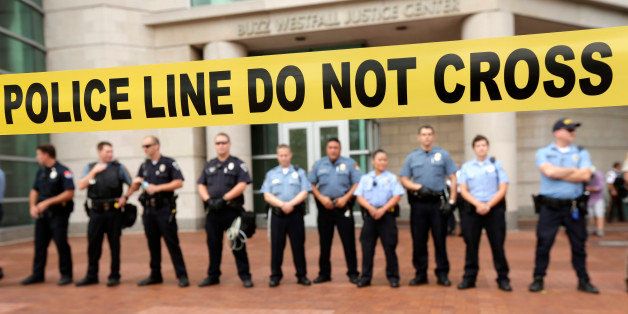
Is Ferguson a consciousness-changing moment? There is evidence that it could be -- for white Americans. African-Americans have long been aware of brutal police behavior. Now the protests in Ferguson, Missouri, and the police response to them are raising consciousness of the problem among whites.
The shock is not only that a police officer killed an unarmed black teenager. That, tragically, has happened too many times before, and when the details remain murky, many people withhold judgment. In last week's Pew poll, two-thirds of whites said they "didn't know enough to say" whether the shooting of Michael Brown was "justified or not justified."
The shock was that the police response to the protests was so hugely disproportionate, "like an invading army." The Pew poll showed little disagreement between whites and African-Americans over the display of militarized power by the local police in response to the protests. Eighty percent of blacks and 65 percent of whites agreed that local police forces should not have "military weapons and vehicles such as assault rifles and tanks." The image of young people with their hands raised shouting "Hands up, don't shoot" will remain a searing reminder of public outrage.
Columbia University Prof. Fredrick Harris describes "transformative episodes that remake perceptions and force a society to abandon abhorrent practices." They are consciousness-changing moments: rare occurrences when a vivid experience causes public awareness of a problem to change virtually overnight.
One of them was the Supreme Court confirmation hearings for Clarence Thomas in October 1991. Until Anita Hill gave her testimony, most men regarded sexual harassment as something of a joke. They thought of it as "flirting." They failed to comprehend women's anger and humiliation. Anita Hill's testimony turned out to be one of those rare moments when public consciousness changed. After Prof. Hill testified about her degrading experiences, sexual harassment was transformed overnight from a joke to a crime.
When Rosa Parks refused to give up her seat on a bus to a white man in Montgomery, Alabama, in 1955, her action released the pent-up anger and frustration of millions. Southern whites, who had allowed themselves to believe that segregation worked, suddenly saw how outraged black people were to live under Jim Crow laws. Consciousness changed. And eventually, a racial caste system was overturned by the civil rights movement.
When Matthew Shepard was brutally murdered on a Wyoming fence post in 1998, the public began to understand the violence and hatred gay people face. Previously, many Americans saw gay rights as a solution for which there was no known problem. But consciousness changed. Now same-sex marriage is becoming a nationwide reality.
The polls on the Ferguson incident have highlighted "stark racial divisions" (Pew Research Center), "sharp black-white divide" (PBS NewsHour) and "racial divide" (Wall Street Journal). That is certainly the case. In the Pew poll, 80 percent of blacks but only 37 percent of whites felt that the case "raises important issues about race."
Still, there is evidence that white attitudes are changing. A 2013 Pew poll asked the same question about the shooting of another African-American youth, Trayvon Martin, in Florida. In the Martin case, 60 percent of whites thought the race issue was "getting too much attention." That number is down to 47 percent in whites' response to the shooting of Michael Brown. Asked whether the police response to the Ferguson, Missouri, protests went too far, whites were divided (33 percent yes, 32 percent no, 35 percent "don't know").
The long-term trends in attitudes toward the police are revealing. The New York Times-CBS News poll has asked many times over the years whether people generally think of the police "more as friends, more as enemies or neither." The number of blacks who see the police as "friends" declined from 37 percent in 1991 to 30 percent in 1995, 27 percent in 2000 and 23 percent this month. But the percentage of whites who see the police as "friends" has also dropped, from 60 percent in 1991 to 55 in 1995, 52 in 2000 and now 49.
Stark racial divisions clearly persist. But whites are becoming conscious of the reality of the problem. They are beginning to see police behavior toward minorities as threatening and abusive -- something black Americans have been conscious of for decades.
